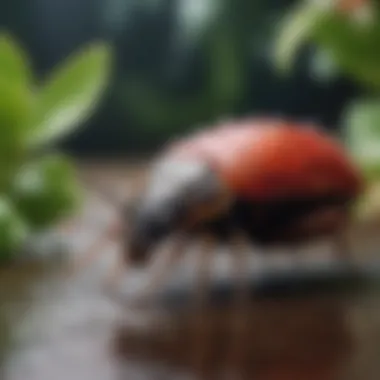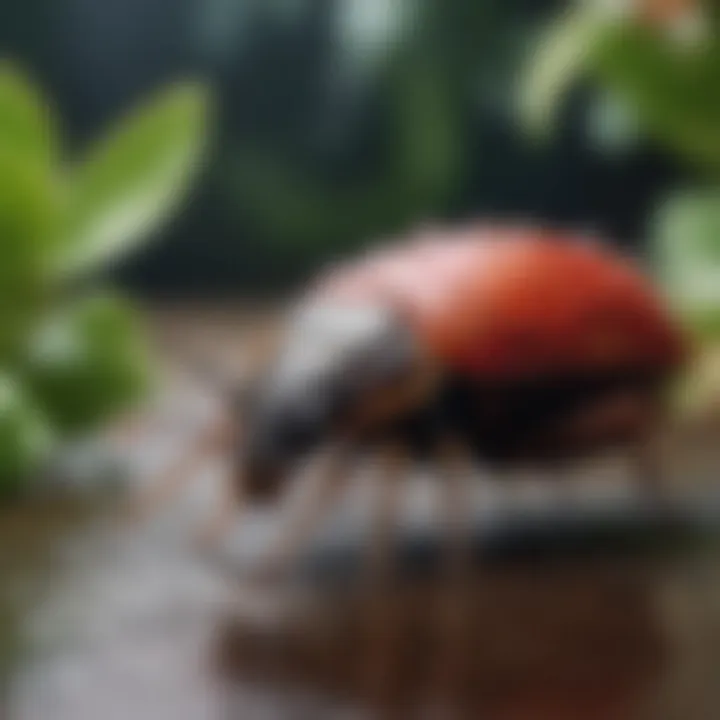Effective Strategies for Eliminating Fruit Bugs


Intro
Fruit bugs, known for their persistent invasion of kitchens and pantries, pose a significant challenge for many homeowners. These small insects often go unnoticed until they become a nuisance, proliferating in areas where fruits and vegetables are stored. Understanding their habits, identifying their presence, and implementing effective eradication techniques are crucial for maintaining a clean and healthy home environment. This article aims to provide an in-depth look at the strategies that can be adopted to effectively eliminate fruit bugs and prevent future infestations.
Identifying Fruit Bugs
Before any elimination strategy can be effective, it is essential to correctly identify fruit bugs. This pest is often mistaken for other common insects. They are typically small and can be recognized by their attraction to decaying or overripe fruits.
Common species include the fruit fly, which is often identified by its reddish eyes and tan body, and the fungus gnat, which is dark and more elongated.
Behavior and Habitat
Fruit bugs thrive in environments where there is a readily available food source. They prefer warm temperatures and can enter a home through open doors or windows, or they may hitch a ride on fruits and vegetables purchased from the grocery store.
Being aware of their behavior allows homeowners to take better preventive measures.
Effective Prevention Techniques
Preventive measures are critical in keeping fruit bugs at bay. Regular cleaning and meticulous storage can significantly mitigate the risk of infestation. Here are some effective strategies:
- Proper Storage: Store ripe fruits and vegetables in the refrigerator, limiting their exposure to the open air. Ensure that any overripe produce is disposed of promptly.
- Effective Cleaning: Maintain kitchen cleanliness by regularly wiping down surfaces, especially where food is prepared and stored. A simple mixture of vinegar and water can effectively remove residue that may attract pests.
- Seal Entry Points: Inspect windows and doors for any gaps that might allow pests to enter. Use screens whenever possible.
"Prevention is the first step in maintaining a pest-free environment."
Practical Steps for Removal
In the unfortunate event of a fruit bug infestation, timely action is required. Here are some targeted solutions to eliminate these pests effectively:
- Traps: Utilize vinegar traps. Fill a bowl with apple cider vinegar and cover it with plastic wrap. Poke small holes for the bugs to enter but not escape.
- Chemical Solutions: Consider insecticidal sprays, but use them cautiously, especially in areas where food is prepared or consumed. Always read the label and follow instructions closely.
- Natural Remedies: Neem oil or essential oils, such as peppermint or eucalyptus, can repel fruit bugs without harsh chemicals.
Cleanup After Eradication
Once the fruit bugs have been successfully eliminated, a thorough cleanup of the affected areas is necessary. This includes:
- Disposing of any food items that were infested.
- Deep cleaning surfaces and containers where fruit was stored.
- Reviewing and adjusting storage practices to prevent future issues.
Closure
Dealing with fruit bugs requires a multifaceted approach involving identification, prevention, and removal strategies. By understanding the habits of these pests and maintaining vigilant cleaning practices, homeowners can create a living space that remains pest-free. With careful management and proactive measures, the intrusion of fruit bugs can be effectively mitigated.
For further reading, you can explore more resources on the topic of pest management at Wikipedia or consult detailed articles on Britannica.
Engaging with communities on platforms such as Reddit or Facebook may also provide useful insights and shared experiences from other homeowners.
Understanding Fruit Bugs
Understanding fruit bugs is essential for effective pest control within the home. It lays the groundwork for identifying these pests and devising appropriate strategies for removal and prevention. By gaining knowledge about the types of fruit bugs, their behaviors, and preferred environments, homeowners can adopt a proactive stance against infestations. This section introduces the various types of fruit bugs and their behaviors, which are vital for effective management.
Types of Fruit Bugs
Fruit flies
Fruit flies are small insects often found around ripe or fermenting fruits. Their biological adaptability makes them prolific reproducers. Adult fruit flies can lay hundreds of eggs on a single piece of fruit, leading to quick population growth. The key characteristic is their ability to thrive in various environments, particularly kitchens and gardens. These features emphasize the importance of controlling this species.
The significant drawback of fruit flies is their rapid reproduction cycle. If not addressed quickly, they can infest an area almost overnight. This makes it essential for homeowners to maintain cleanliness in food storage areas and act immediately upon noticing them.
Mealybugs
Mealybugs are another common pest that often targets indoor plants and fruits. Their appearance is distinct, featuring a white, cottony wax covering. This covering makes them easily identifiable, which is a beneficial aspect for those looking to manage pest populations. Unlike fruit flies, mealybugs feed on plant sap, causing weakening and potential death to plants.
A unique feature of mealybugs is their resistance to some common pesticides. While they are recognizable, their elimination may require more specific treatments. This can lead homeowners to seek out specialized insecticides or organic solutions for effective management.
Aphids
Aphids are small sap-sucking insects that can cause significant damage to plants, including fruit-bearing ones. They come in various colors but are typically small and pear-shaped. A key characteristic is their ability to reproduce rapidly by a method called parthenogenesis, allowing for sudden population boosts.
The impact of aphids can be substantial. Their feeding habits weaken plants, making them susceptible to diseases. Therefore, recognizing their presence quickly is essential to prevent extensive damage to home gardens and indoor plants.
Behavioral Patterns
Feeding habits
The feeding habits of fruit bugs significantly contribute to their potential for destruction. Each species has unique preferences, affecting not only the types of fruits they target but also the methods required for removal. For example, fruit flies prefer overripe fruits due to high sugar content, making those items prime targets.
Understanding feeding habits aids homeowners in implementing preventive measures. By noting which fruits attract pests, individuals can store perishables appropriately, minimizing exposure and risk of infestation.
Reproduction cycles
Reproduction cycles for fruit bugs vary significantly across species. For fruit flies, the cycle can complete in as little as a week, enabling rapid population growth. This characteristic poses a major threat in a short span. In contrast, mealybugs may take longer to reproduce, yet they can remain hidden for extended periods.
This knowledge of reproduction cycles allows for informed timing when deciding on treatments. Intervening at the right moment in the cycle increases the chances for successful pest control.
Preferred environments
Preferred environments vary among fruit bugs as well. Fruit flies thrive in warm, moist areas, often near fruit bowls or compost bins. Conversely, mealybugs prefer indoor plants with adequate humidity but can also be found in outdoor gardens in warm seasons.
Recognizing where these pests tend to thrive allows homeowners to monitor those areas closely. An awareness of their preferred environments improves surveillance and proactive measures against potential infestations.
Identifying an Infestation


Identifying an infestation of fruit bugs is a crucial step in effective pest management. Early detection allows homeowners to take swift action. This can prevent pests from multiplying and spreading throughout the home. Being aware of the signs of infestation can save both time and money when dealing with these insects. It highlights the importance of vigilance in maintaining a clean and healthy living environment.
Signs of Presence
Visible bugs on fruits
Visible bugs on fruits are one of the immediate indicators of an infestation. These pests are often small, which can make them hard to see until the problem escalates. It is common for homeowners to first notice these bugs on ripened or overripe fruits. The presence of these insects compromises the integrity of the fruit, making it unfit for consumption. Detecting visible bugs promptly can be beneficial, as it encourages immediate action to remove the affected items.
Sticky residues
Sticky residues on surfaces or fruits can also signal a fruit bug problem. Many types of fruit bugs produce sticky excretions known as honeydew. This residue attracts other pests and can lead to further complications such as mold growth. Identifying these residues early can help in pinpointing the source of the problem. Cleaning areas with sticky residues can prevent other issues from developing, contributing to a healthier home environment.
Presence of larvae
The presence of larvae is a significant sign of a more advanced infestation. If small white or gray larvae are found on or near fruits, it indicates that you may already have a breeding population. Larvae can cause substantial damage to fruits and vegetables. Recognizing larvae signals an urgent need for intervention, as this can escalate quickly. Effective monitoring can keep the pest population in check before it causes irreversible harm.
Common Affected Areas
Kitchens
Kitchens are often prime locations for fruit bug infestations. The presence of food scraps or overripe fruits can attract these pests. Kitchen counters, pantry shelves, and even the inside of cabinets can serve as hotspots for fruit bugs. Regular cleaning and monitoring of these spaces will help identify potential problems. Being proactive in maintaining cleanliness in kitchens is crucial for preventing infestations.
Fruit bowls
Fruit bowls are particularly susceptible to hosting fruit bugs. They provide a convenient and accessible place for pests to feed and breed. The choice to keep fresh fruits in bowls can be beneficial for its aesthetic appeal but can invite fruit flies and other bugs. Rotating the fruits and inspecting the bowl regularly can help in keeping bugs at bay. Choosing enclosed storage options is another strategy to minimize exposure.
Gardens
Gardens can be breeding grounds for various types of fruit bugs. They thrive in environments where fruits and vegetables are readily available. Regular inspections of plants and the ground can help in detecting any pest-related issues early on. Proper care and maintenance of the garden also deter infestation by creating a less favorable environment for fruit bugs. Implementing strategic planting of pest-resistant varieties can be advantageous as well.
Preventive Measures
Preventive measures are essential in maintaining a fruit bug-free home. These strategies significantly reduce the likelihood of an infestation before it even starts. By focusing on effective techniques, homeowners can create an environment that bugs find inhospitable. Proper management not only helps in reducing pest populations but also enhances the overall cleanliness and hygiene of domestic spaces.
Proper Food Storage
Proper food storage is a fundamental aspect of preventing fruit bugs. This practice ensures that food remains unblemished and less appealing to pests.
Sealing containers
Sealing containers effectively protects food items from potential fruit bug infestation. These containers are designed with airtight lids that prevent pests from accessing the food inside. Using sealed containers is a beneficial choice as it keeps produce fresh for longer periods without exposure to bugs.
The unique feature of sealing containers is their ability to maintain a controlled environment for stored items. This minimizes the risk of contamination and limits odors that may attract pests. The downside, however, can be the initial cost for high-quality containers. Overall, sealing is a reliable method to safeguard food.
Refrigeration practices
Refrigeration practices are another vital element for preventing fruit bugs. Storing perishable goods in a refrigerator slows down the spoilage process and deters insect activity. This practice is favored because it not only keeps food fresh but also provides a cold environment that most fruit bugs dislike.
One of the unique features of refrigeration is its dual function of extending food life while disabling pest reproduction cycles. However, a drawback could be energy consumption, although benefits far outweigh this concern.
Regular Cleanliness Routines
Regular cleanliness routines are crucial in the ongoing battle against fruit bugs. Routine cleaning ensures that any food residues which could draw pests are systematically removed.
Wiping surfaces
Wiping surfaces is an effective way to eliminate potential food sources for fruit bugs. It involves regularly cleaning counters, tables, and other surfaces where food might be prepared or consumed. This practice significantly reduces the risk of attracting pests.
The key characteristic of wiping surfaces is its simplicity and speed. A beneficial choice, it requires minimal resources and can be easily incorporated into daily routines. One disadvantage might be the temptation to overlook certain areas, which can lead to problems if not consistently checked.
Cleaning spills promptly
Cleaning spills promptly is another critical aspect of maintaining a bug-free home. Spills can become hotspots for pests if they are not addressed quickly, making this practice vital. This not only prevents fruit bugs from being attracted to the area but also ensures cleanliness.
The unique feature of prompt cleaning is that it requires immediate action, reinforcing the idea that attention to detail can make a significant difference. The downside is the repetition needed to keep up with daily spills from meals or snacks.
Waste Management
Proper waste management is significant in preventing fruit bugs from infiltrating your home. This involves maintaining a clean environment, free of discarded food remnants that attract these insects.
Proper disposal of fruits
Proper disposal of fruits that have gone bad is an essential action in waste management. Disposing of rotting produce limits the food sources available for pests. This is a beneficial choice among strategies due to its straightforward application.
The unique characteristic here lies in the routine assessment of fruits for spoilage, promoting proactive measures against infestation. On the downside, improper disposal can lead to odors and even fly attraction if not done systematically.
Use of sealed trash bins
The use of sealed trash bins is instrumental in waste management practices. These bins can contain odors and prevent access for fruit bugs. Choosing sealed bins is a popular option due to their efficacy in limiting attractants that may draw pests into living spaces.
One unique feature of sealed trash bins is their ability to be reinforced with features that deter insect access. For example, bins with locking mechanisms provide additional layers of protection. However, they may come with higher costs compared to regular bins, which could be a consideration for some homeowners.
Natural Remedies for Removal
Natural remedies play a pivotal role in the strategies for eliminating fruit bugs. They offer a more organic approach, minimizing the reliance on potentially harmful chemicals that could affect indoor air quality and the well-being of household members. These remedies are often safer for pets and children, making them an attractive choice for many homeowners. Additionally, they can be cost-effective solutions, utilizing common household items to tackle pest issues effectively.


When considering natural remedies, it is essential to understand their efficacy and practical application. Some remedies act as preventive measures while others serve as active removal techniques. Embracing these methods can lead to a long-term commitment to maintaining a pest-free environment with minimal chemical exposure.
Homemade Traps
Vinegar traps
Vinegar traps are a straightforward solution for attracting and trapping fruit flies. They utilize the strong smell of vinegar, particularly apple cider vinegar, to lure the bugs into a vessel. Once inside, the flies find it challenging to escape.
An important characteristic of vinegar traps is their accessibility. Most households already have vinegar on hand, eliminating the need for additional purchases. The simplicity of this trap makes it a popular choice among homeowners for quick and effective pest control. The unique feature of vinegar traps lies in their ability to provide immediate results without the use of toxic substances.
However, vinegar traps do have limitations. They may not address infestations that are already severe. In such cases, more robust methods might be necessary. While vinegar traps can effectively reduce fly populations, they should be considered as part of a broader pest management strategy.
Soap water solutions
Soap water solutions offer another natural method for removing fruit bugs. Soap acts as a surfactant, breaking down the protective coating on insects, leading to their demise. This method can be very effective for dealing with small bugs like aphids and certain larvae.
The key characteristic of soap water solutions is their versatility. They can be applied directly onto affected plants and fruits without causing damage if used appropriately. Their beneficial nature lies in their environmental safety, as they do not leave behind harmful residues. The unique feature of soap solutions is their readiness for use; you can easily create them with household items.
However, caution is necessary with soap solutions. Not all soaps are suitable, and using those with additives may harm plants or fruits. Additionally, repeated applications are often necessary to achieve desired results. Thus, while beneficial, soap water solutions require careful application and monitoring.
Essential Oils
Essential oils have gained recognition for their potential to repel pests, including fruit bugs. The strong scents emitted by these oils can disrupt the natural behavior of insects, making them less likely to infest treated areas. Eucalyptus oil and peppermint oil are two of the most effective options in this regard.
Eucalyptus oil
Eucalyptus oil is particularly effective as a repellent for various species of fruit bugs. Its strong aroma confuses these pests, deterring them from approaching areas where it is applied. This essential oil is a beneficial choice because it not only repels pests but also offers a pleasant scent for humans.
The unique feature of eucalyptus oil is its dual purpose. Beyond repelling bugs, it can also promote a fresher indoor atmosphere. However, excessive use may lead to overpowering scents, making it necessary to balance application for effectiveness and comfort.
Peppermint oil applications
Peppermint oil applications serve as another natural deterrent against fruit bugs. The menthol scent is both refreshing and effective at keeping pests at bay. This oil is a popular choice among households seeking non-toxic pest control methods due to its availability and aroma.
A distinctive feature of peppermint oil is its versatility; it can be mixed with water for spraying or added to homemade traps for increased efficacy. Alongside its advantages, the strong scent can also be a hindrance. Sensitive individuals might find it overwhelming, necessitating limited use in certain environments.
Chemical Solutions
Chemical solutions play an important role in addressing fruit bug infestations. They can provide quick and effective results when natural methods have not sufficed. Using the right chemical treatments can significantly lessen the pest population, ultimately leading to a more comfortable and hygienic home environment. However, it is essential to approach the use of chemicals with care to minimize risks to both human and pet health.
Pesticides Consideration
Selecting suitable products
Selecting suitable products is critical in effectively managing fruit bugs. The right pesticide can enhance the chances of eliminating these pests with minimal side effects. It's vital to choose pesticides specifically designed for fruit bugs rather than general pest control solutions. These specialized products often contain targeted active ingredients that can effectively disrupt the life cycle of fruit bugs.
Some key characteristics to consider include:
- Target specificity: Choose products that specifically indicate effectiveness against fruit flies, for example, as opposed to more broad-range pesticides.
- Residual effect: Evaluate how long the pesticide remains effective after application; certain products may continue to kill pests for days or weeks.
Opting for suitable products can provide homeowners with a sense of security. A beneficial choice often results in fewer applications needed over time, translating into cost savings and reduced pesticide exposure in the household.
Safety precautions
Safety precautions are essential when using chemical solutions to manage fruit bugs. Knowing how to protect oneself, pets, and the environment can greatly enhance the effectiveness of pesticide applications while also mitigating risks.
The following key points summarize safety considerations:
- Reading labels: Always consult product labels for specific usage instructions and safety guidelines.
- Protective gear: Wearing gloves and masks during application can protect against potential skin irritations or inhalation of harmful substances.
Adopting safety precautions fosters a more secure environment for everyone in the home. While these practices may require some extra time and effort, they ensure that chemical solutions yield effective results without compromising health and safety.
Application Techniques
Targeting affected areas
Targeting affected areas is a strategic approach when applying pesticides. This technique allows homeowners to focus their efforts on specific regions where fruit bugs are most prevalent. By concentrating on affected areas, it minimizes pesticide wastage and enhances the efficacy of the treatment.
Key aspects include:
- Identifying hotspots: Check places where fruit is stored, thrown away, and where pests are typically seen.
- Direct spraying: Directly applying pesticides to these areas proves more efficient than general spraying across vast spaces.
This precision can result in quicker infestations management, making targeting a smart choice for pest control.
Frequency of application
Frequency of application is vital in maintaining effective pest control. For many pesticides, one-time application may not suffice, particularly with re-infestations possibly occurring. Understanding how often to apply products can lead to more strategic pest management.
Consider the following points:
- Product recommendations: Follow the manufacturer's guidelines for how often to reapply.
- Environmental conditions: Weather, humidity levels, and the lifecycle stages of fruit bugs may necessitate adjustments in application frequency.
Consistency in application can play a significant role in controlling fruit bug populations over time, ultimately supporting a successful pest management strategy.


Long-Term Solutions
Long-term solutions play a crucial role in managing fruit bugs effectively. Many homeowners experience repeated infestations if they focus solely on immediate removal methods. Therefore, a strategic approach that includes sustainable practices can significantly lower the chances of future outbreaks.
Implementing long-term strategies helps create a less favorable environment for these pests. This ensures that once you eliminate the current infestation, you do not face the same issue again shortly after. The emphasis here is not just on eradication but also on prevention and management, which can lead to a more comfortable and hygienic living space.
Integrated Pest Management
Combining Techniques
Combining techniques refers to the integration of various pest control methods into a cohesive strategy. It is essential because this multifaceted approach increases effectiveness in dealing with fruit bugs. Instead of relying solely on one method, homeowners can tackle the problem from multiple angles. This not only helps in removing existing pests but also minimizes the risk of them returning.
The key characteristic of combining techniques is flexibility. By blending natural remedies, chemical solutions, and preventive measures, you can tailor a unique strategy that fits specific circumstances in your home. One advantage of this approach is its adaptability; homeowners can switch methods based on effectiveness. However, an important consideration is ensuring that the combined methods do not interfere with each other, which requires careful planning.
Monitoring Pest Activity
Monitoring pest activity is vital for achieving long-term control over fruit bugs. Regular observation enables homeowners to be proactive rather than reactive. By identifying early signs of re-infestation, actions can be taken before the situation escalates.
The benefit of monitoring is that it provides continuous insight into pest prevalence. Homeowners can adjust their strategies based on findings, leading to a more streamlined pest management plan. A significant feature of this aspect is its emphasis on vigilance, fostered through routine checks. However, it does require commitment and need to be part of an overall home maintenance routine.
Landscaping Considerations
Choosing Pest-Resistant Plants
Choosing pest-resistant plants is a strategic landscaping consideration that supports long-term pest management goals. By selecting flora that naturally deters fruit bugs, the overall ecosystem of your garden becomes healthier. This proactive approach promotes biodiversity, which can further decrease pest activity.
A notable characteristic is the reduced need for chemical treatments when pest-resistant plants are incorporated. This not only benefits your garden but also contributes to a healthier living environment. On the downside, pest-resistant plants can sometimes be more expensive or less available, which necessitates careful planning when establishing a garden.
Creating Barriers
Creating barriers effectively limits access points for fruit bugs into your home and garden. This strategy can involve physical barriers such as nets and screens or cultural methods such as plants placed strategically to disrupt pest entry.
The primary characteristic of this approach is that it is preventive in nature. By establishing mechanisms to block pests from entering, you not only protect existing plants but also maintain a pest-free home environment. However, one drawback is the maintenance of these barriers, as they require regular inspection and potential repairs to remain effective.
"The combination of integrated pest management and proper landscaping choices can significantly enhance the overall health of your home ecosystem while minimizing insect presence."
By focusing on long-term strategies, homeowners can ensure a more permanent resolution to fruit bug issues. It is about creating an environment that naturally resists these pests while promoting a healthier space for dwelling.
Seeking Professional Help
In the realm of pest control, knowing when to seek professional help can make the difference between a minor annoyance and a serious infestation. The importance of this decision cannot be understated. Homeowners may attempt various DIY methods to rid their spaces of fruit bugs, but there are times when these approaches fall short. Engaging a professional exterminator can provide a more streamlined and effective solution for significant infestations, ensuring the problem is handled decisively and efficiently.
When to Call an Exterminator
Signs of full-blown infestation
Recognizing the signs of a full-blown infestation is crucial. This could include a sudden increase in visible bugs, particularly in kitchen areas, and the persistence of these bugs despite attempts to remove them. One key characteristic to note is the sheer quantity of fruit bugs. When homeowners begin to notice more than just a few insects lingering around fruit bowls or kitchen shelves, it is a clear indication that a professional may be needed. This situation not only simplifies the pest control process but also prevents further complications that can arise from an unchecked infestation.
A unique feature of addressing the signs of a full-blown infestation is the comprehensive approach professional exterminators can offer. They can inspect the entire property, identify breeding grounds, and target treatments accordingly. The advantages of acting promptly in this situation cannot be ignored; timely intervention can save the home from more extensive damage and a larger pest problem in the future.
Inadequate home remedies
When home remedies prove inadequate, it becomes necessary to consider alternative solutions. Many homeowners start with home remedies because of their accessibility and often lower cost. However, these improvisations sometimes fail to address the root of the infestation. A critical aspect of inadequate home remedies is that they might only provide temporary relief, rather than long-term solutions.
The key characteristic of relying solely on home remedies is the risk involved. Homeowners may unknowingly create an environment where fruit bugs can thrive, especially if the remedies are not effectively eliminating eggs or larvae. The unique feature of this situation is that it highlights the limits of DIY pest control. While it is a beneficial option for minor issues, it can become disadvantageous if the infestation escalates. Seeking professional assistance eliminates the uncertainty surrounding the effectiveness of such remedies and provides a thorough and sustainable response to the issue at hand.
"In many cases, a swift response curtails the risk of further damage and provides peace of mind, making professional intervention worthwhile."
By understanding when to seek professional help, homeowners can significantly improve their chances of effectively eliminating fruit bugs from their environment.
Maintaining a Bug-Free Environment
Maintaining a bug-free environment is crucial for homeowners who want to enjoy their living spaces without the intrusion of pests like fruit bugs. It not only protects the hygiene of your home but also contributes to the overall well-being of your family. Being proactive in pest control measures can lead to fewer infestations, ensuring comfort and peace of mind in your daily life.
Ongoing Monitoring
Regular inspections
Regular inspections play a vital role in identifying and addressing potential fruit bug problems before they escalate. By systematically checking areas such as kitchens, fruit storage, and gardens, homeowners can notice early signs of these pests. One key characteristic of regular inspections is they encourage a consistent habit of vigilance. This approach is equally beneficial as it helps in quickly spotting changes in pest activity.
The unique feature of regular inspections is their preventive aspect; they allow for the early detection of infestations, enabling you to act promptly. The main advantage is the reduced likelihood of a major infestation, saving both time and money in potential treatments. However, it requires some commitment and time to implement, which might be perceived as a disadvantage.
Adapting strategies
Adapting strategies refers to the ability to modify your pest control plans based on ongoing observations and results. This current aspect helps in fine-tuning methods that may not be effective, ensuring that your efforts remain impactful. This flexibility is a popular choice for homeowners aiming for a sustainable approach to pest management.
The unique feature here is the customized aspect of the approach. Understanding what works and what does not allows for better utilization of resources. The main advantage of adapting strategies is that it fosters a dynamic response to pest control, which can lead to better outcomes over time. However, one potential downside is that it may require continuous learning and monitoring to determine the best practices for each situation.
Educating Household Members
Cooperation in maintenance
Cooperation in maintenance is essential for creating a unified front against fruit bugs. When everyone in a household participates in upkeeping cleanliness and implementing pest control measures, effectiveness increases significantly. A key characteristic of cooperation is the shared responsibility that enhances community effort within the home, making it richer in engagement for each member.
The unique feature of cooperation in maintenance is the engagement aspect; it motivates individuals to take part in maintaining a clean environment. The main advantage is a reduced likelihood of neglecting areas, thereby making the household less inviting to fruit bugs. Yet, this approach may face challenges, such as varying levels of commitment among household members.
Awareness of pest management
Awareness of pest management ensures that all household members are informed about best practices in preventing and dealing with fruit bugs. Education plays a crucial role; it fosters understanding of the life cycle of these pests, their preferred habitats, and prevention methods. A significant characteristic of awareness is that it empowers individuals to recognize early signs of infestations, allowing for quicker response.
The unique feature of awareness of pest management is that it creates an informed household, making pest control a community effort. The advantage is that an educated group tends to make better choices regarding cleanliness and pest control, as each member can recommend solutions and strategies. However, a downside may be the varying degrees of interest or understanding among individuals, which could lead to gaps in participation and effectiveness.















